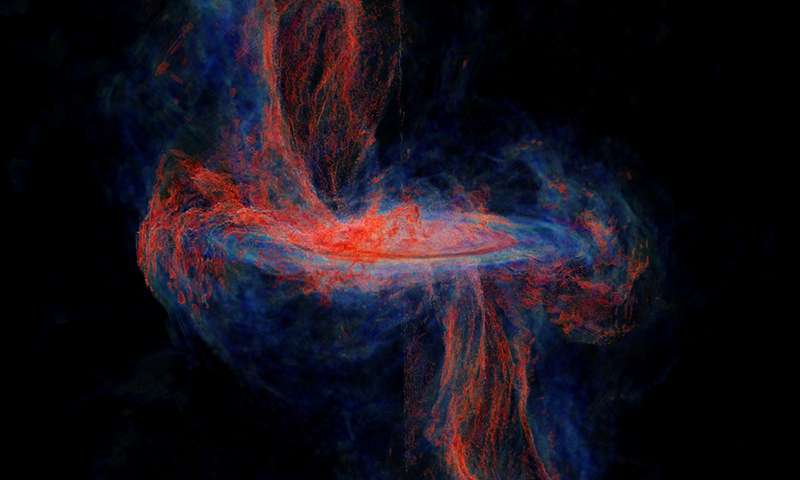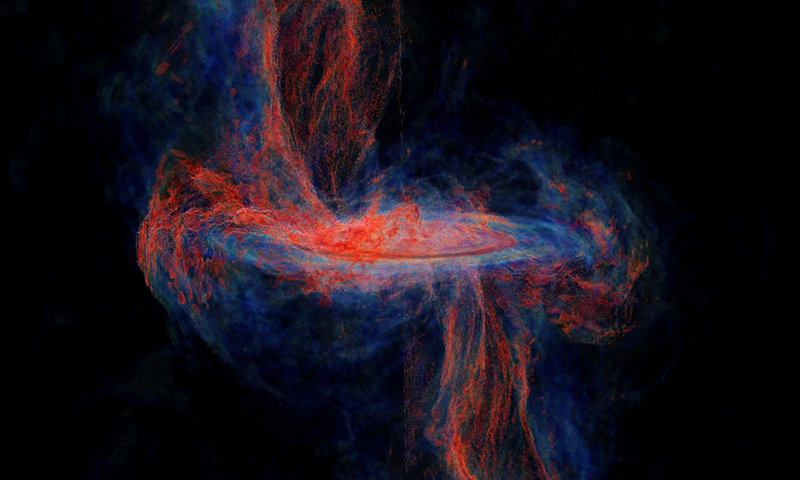New Way for a Black Hole to be a Messy Eater
Five to ten percent of the black holes in galaxies sit at the center of an accretion disk, where blobs of plasma slowly lose angular momentum and spiral inward to feed the black hole. In a simulation, Nicholas Kaaz of Northwestern University, Illinois, and his collaborators now find that for a rapidly spinning black hole surrounded by a thin, tilted disk this “eating” process is quicker and messier than previously thought [1].
A black hole’s spin axis and its accretion disk’s orbital axis are sometimes misaligned. When that happens, local spacetime distorts, driving rotational stresses that can warp the disk. Kaaz and his colleagues included this behavior in their simulation, along with other features of general relativity. They also incorporated the magnetohydrodynamic equations that describe plasma behavior.
To derive a detailed picture of the physical processes, the simulation occupied a spherical grid that contained 22 billion active cells, compared to the tens of millions normally used, Kaaz says. As such, the simulation took three months to run on the world’s fifth fastest computer, Summit, at Oak Ridge National Laboratory in Tennessee.
In the simulation, the black hole rotated at close to its maximum speed, and its spin axis tilted at 65° with respect to the orbital axis of an initially flat, rotating accretion disk. The parts of the disk close to the black hole’s event horizon quickly warped, generating stresses so severe that the disk repeatedly tore, splitting into inner and outer rings separated by mostly empty space. Magnetohydrodynamic forces then repeatedly rejoined the rings.
The team identified and named two new energy-dissipation mechanisms—nozzle shocks and streamers—that reduced angular momentum and enhanced accretion whether or not the disk was torn. Nozzle shocks arose when the warp swept through the disk, compressing it and forcing material radially inward and outward. Nozzle shocks appeared twice an orbit. In the rest of the disk, the warp induced radial oscillations that launched material vertically in streamers that then fell back onto the inner disk. Together, the streamers, nozzle shocks, and the disk splitting boosted both the rate and variability of accretion onto the back hole. “Quasars harboring such warped disks should vary in luminosity by a factor of 30 over timescales of months to years,” Kaaz says.
The simulation indicates what might happen when axes misalignment is high and black hole spin is rapid. Although the likelihood of that combination is uncertain, Kaaz and his colleagues point out that their findings could explain so-called changing-look active galactic nuclei (CL AGN). This subset of AGN undergo extreme luminosity excursions that last months to years. Traditional theories, which assume that viscous stresses govern disk conditions, struggle to account for rapid and intense swings in accretion and, with it, luminosity.
Julian Krolik of Johns Hopkins University, Maryland, who studies accretion disks, notes that the simulation’s initial conditions are somewhat narrow. Still, he says, “it’s definitely an interesting result, as it demonstrates that such things can happen.”
–Charles Day
Charles Day is a Senior Editor for Physics Magazine.
References
- N. Kaaz et al., “Nozzle shocks, disk tearing, and streamers drive rapid accretion in 3D GRMHD simulations of warped thin disks,” Astrophys. J. 955, 72 (2023).





